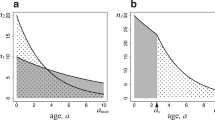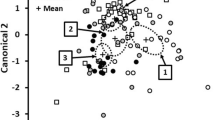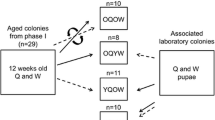Abstract
Division of labor among size and age classes in social insect colonies is a fundamental aspect of sociality, with such classes typically showing behavioral specialization and being associated with particular tasks for prolonged periods of time (i.e., forming castes). Theoretically, such specialization and division of labor enhance efficiency and, ultimately, reproductive success, and the ratios among members of those castes are hypothesized to be under selection and adaptive. However, our recent field study of the ant Pheidole dentatashowed no correlation between ecological factors which should affect colony growth and those caste ratios but implied flexibility in the association between minor worker age castes and their tasks. In laboratory experiments on behavioral flexibility in minor age castes of P. dentataold workers in colonies without young workers competently perform both old worker (caste“typical”) and young worker (“atypical”) tasks, and vice versa. The implications of these results for ergonomie theory are considered.
Similar content being viewed by others
References
Bhatkar, A., and Whitcomb, W. H. (1970). Artificial diet for rearing various species of ants.Fla. Entomol. 53: 229–232.
Brian, A. D. (1952). Division of labor and foraging inBombus agrorum Fabricius.J. Anim. Ecol. 2: 223–240.
Calabi, P. (1988). Behavioral flexibility in Hymenoptera: A re-examination of the concept of caste. In Trager, J. C. (ed.),Advances in Myrmecology, E. J. Brill Press, Leiden, pp. 237–258.
Calabi, P., and Rosengaus, R. (1988). Interindividual differences based on transition probabilities in the antCamponotus sericeiventris. In Jeanne, R. L. (ed.),Interindividual Behavioral Variability in Social Insects, Westview Press, Boulder, Colo., pp. 61–89.
Calabi, P., and Traniello, J. F. A. (1988). On the adaptive nature of social organization: caste ratios in the antPheidole dentata lack ecological correlates.Behav. Ecol. Sociobiol. 24: 69–78.
Dobrzanska, J. (1959). Studies on the division of labor in ants of the genusFormica. Acta Biol. Exp. Warsaw19: 57–81.
Ehrhardt, S. (1931). Uber arbeitsteilung beiMyrmica- und Messor-Arten.Z. Morphol. Okol. Tiere 20: 755–812.
Free, J. (1955). The division of labor within bumblebee colonies.Insectes Soc. 2: 195–212.
Free, J. (1965). Allocation of duties among worker honeybees.Symp. Zool. Soc. Lond. 14: 39–59.
Gentry, J. B. (1974). Responses to predation by colonies of the harvester ant.Pogonomyrmex badius. Ecology 55: 1328–1338.
Gregg, R. E. (1942). The origin of castes in ants with special reference toPheidole morrisi (Forel).Ecology 23: 295–308.
Hebling, N. J., Kerr, W. E., and Kerr, F. S. (1964). Divisao de trahbalho entre operarias deTrigona (Scaptotrigona)xanthotricha Moure. Cited by Michener, C. D. (1974).The Social Behavior of Bees, The Belknap Press of Harvard University Press, Cambridge, Mass.
Johnston, A., and Wilson, E. O. (1985). Correlates of variation in the major/minor ratio of the antPhedole dentata (Hymenoptera: Formicidae).Ann. Entomol. Soc. Am. 78: 8–11.
King, R. L., and Sallee, R. M. (1962). Further studies on mixed colonies of ants.Iowa Acad. Sci. 69: 531–539.
Kolmes, S. A. (1985). An ergonomie study ofApis mellifera (Hymenoptera: Apidae).J. Kans. Entomol. Soc. 58: 413–421.
Lenoir, A. (1979). Feeding behavior in young societies of the antTapinoma erraticum L.: Trophallaxis and polyethism.Insectes Soc. 26: 19–37.
McDonald, P., and Topoff, H. (1985). The social regulation of behavioral development in the antNovomessor albisetosus. J. Comp. Psychol.99: 3–14.
Meudec, M., and Lenoir, A. (1982). Social responses to variation in food supply and nest suitability in ants(Tapinoma erraticum). Anim. Behav.30: 284–292.
Michener, C. D. (1974).The Social Behavior of Bees: A Comparative Study, The Belknap Press of Harvard University Press, Cambridge, Mass.
Mirenda, J. T., and Vinson, S. B. (1979). A marking technique for adults of the red imported fire ant (Hymenoptera: Formicidae).Fla. Entomol. 62: 279–281.
Oster, G. F., and Wilson, E. O. (1978).Caste and Ecology in the Social Insects, Princeton University Press, Princeton, N.J.
Porter, S. D. (1988). Impact of temperature on colony growth and developmental rates of the antSolenopsis invicta.J. Insect. Physiol. 34: 1127–1133.
Porter, S. D., and Tschinkel, W. R. (1985). Fire ant polymorphism: The ergonomics of brood production.Behav. Ecol. Sociobiol. 16: 323–336.
Schmid-Hempel, P., and Schmid-Hempel, S. (1984). Life duration and turnover of foragers in the antCataglyphis bicolor (Hymenoptera: Formicidae).Insectes Soc. 31: 345–360.
Sokal, R. R., and Rohlf, F. J. (1969).Biometry, W. H. Freeman, San Francisco, Calif.
Talbot, M. (1957). Population studies of the slave-making antLeptothorax duloticus and its slave,Leptothorax curvispinosus. itEcology38: 449–456.
Tschinkel, W. R. (1988). Colony growth and the ontogeny of worker polymorphism in the fire ant,Solenopsis invicta. Behav. Ecol. Sociobiol. 22: 103–115.
Wheeler, D. E. (1984). Soldier determination in the antPheidole bicarinata: Inhibition by adult soldiers.J. Insect. Physiol. 30: 127–135.
Wilson, E. O. (1971).The Insect Societies, Belknap Press of Harvard University Press, Cambridge, Mass.
Wilson, E. O. (1975).Sociobiology: The New Synthesis, Belknap Press of Harvard University, Cambridge, Mass.
Wilson, E. O. (1976). Behavioral discretization and the number of castes in an ant species.Behav. Ecol. Sociobiol. 1: 121–154.
Wilson, E. O. (1980). Caste and division of labor in leafcutter ants (Hymenoptera: Formicidae:Atta). I. The overall pattern inA. sexdens.Behav. Ecol. Sociobiol. 7: 143–156.
Wilson, E. O. (1983a). Caste and division of labor in leafcutter ants (Hymenoptera: Formicidae:Atta). III. Ergonomie resiliency in foraging byA. cephalotes.Behav. Ecol. Sociobiol. 14: 47–54.
Wilson, E. O. (1983b). Caste and division of labor in leafcutter ants (Hymenoptera: Formicidae:Atta). IV. Colony ontogeny ofA. cephalotes.Behav. Ecol. Sociobiol. 14: 55–60.
Wilson, E. O. (1984). The relation between caste ratios and division of labor in the ant genusPheidole (Hymenoptera: Formicidae).Behav. Ecol. Sociobiol. 16: 89–98.
Wilson, E. O. (1985). The sociogenesis of social insect colonies.Science 228: 1489–1495.
Winston, M. L., and Fergusson, L. A. (1985). The effect of worker loss on temporal caste structure in colonies of the honeybee(Apis mellifera L.).Can. J. Zool. 63: 777–789.
Winston, M. L., and Katz, S. J. (1981). Foraging differences between cross-fostered honeybee workers (Apis mellifera) of European and Africanized races.Behav. Ecol. Sociobiol. 10: 125–129.
Winston, M. L., and Punnett, E. N. (1982). Factors determining temporal division of labor in honeybees.Can. J. Zool. 60: 2947–2952.
Author information
Authors and Affiliations
Rights and permissions
About this article
Cite this article
Calabi, P., Traniello, J.F.A. Behavioral flexibility in age castes of the antPheidole dentata . J Insect Behav 2, 663–677 (1989). https://doi.org/10.1007/BF01065785
Accepted:
Issue Date:
DOI: https://doi.org/10.1007/BF01065785




